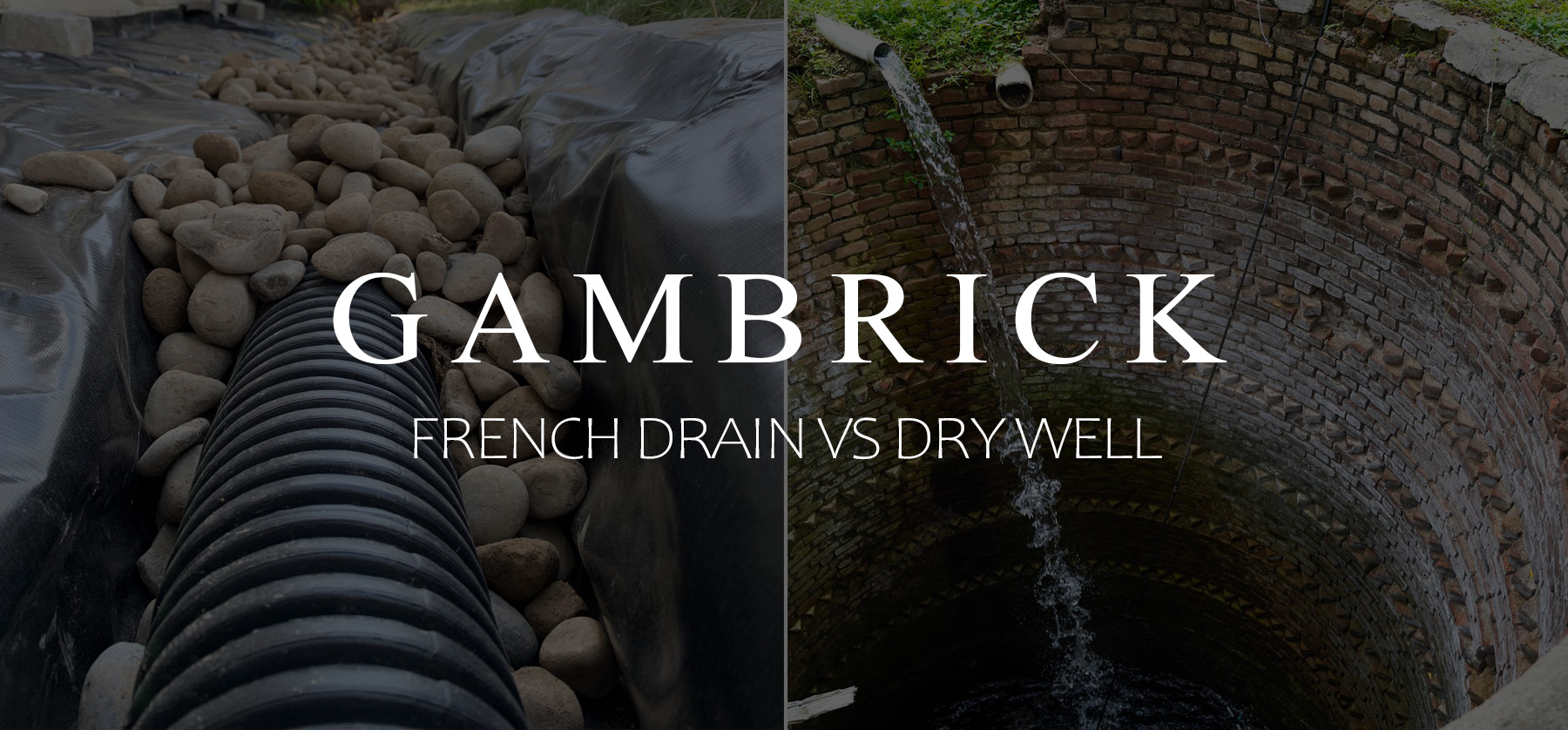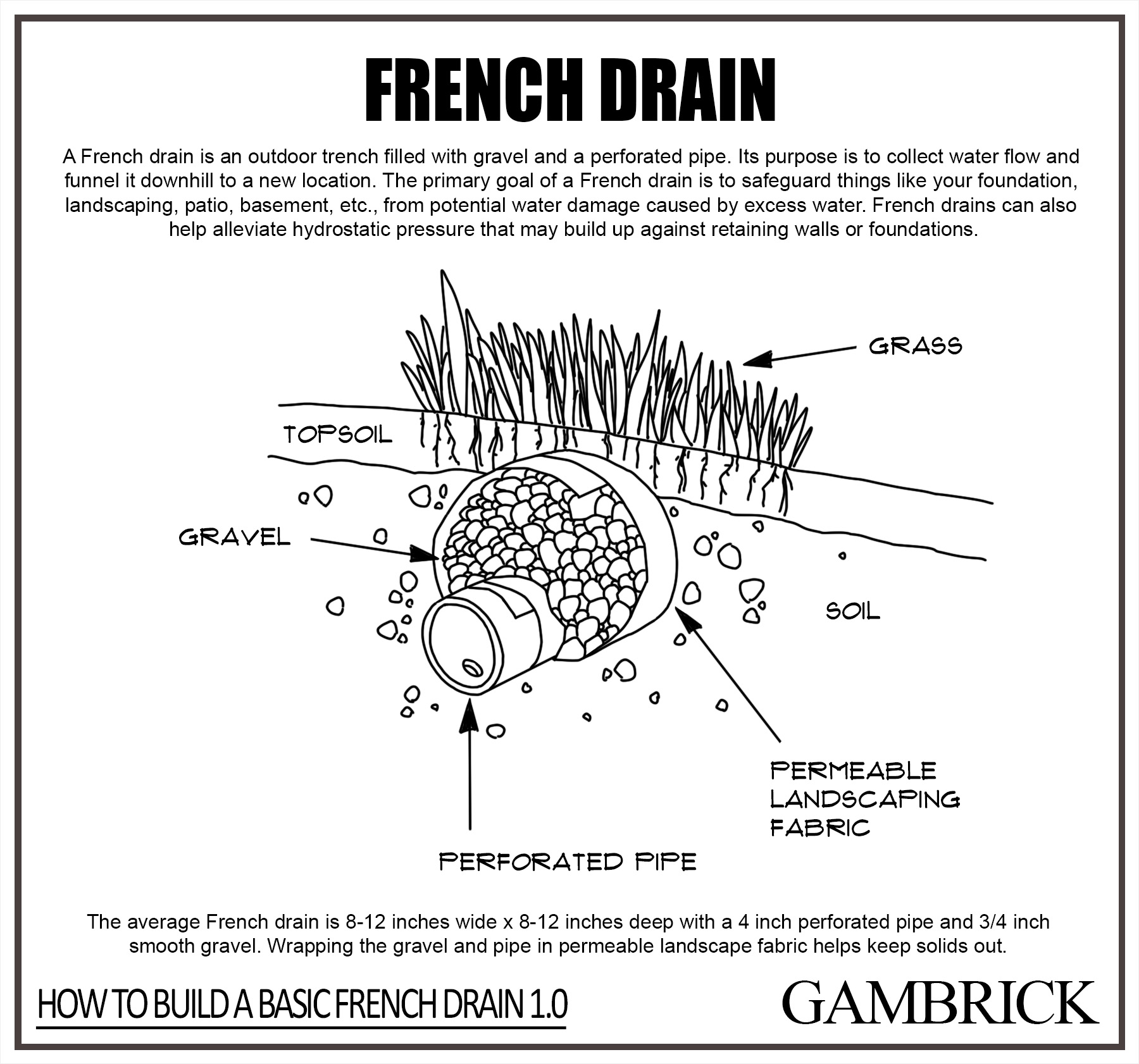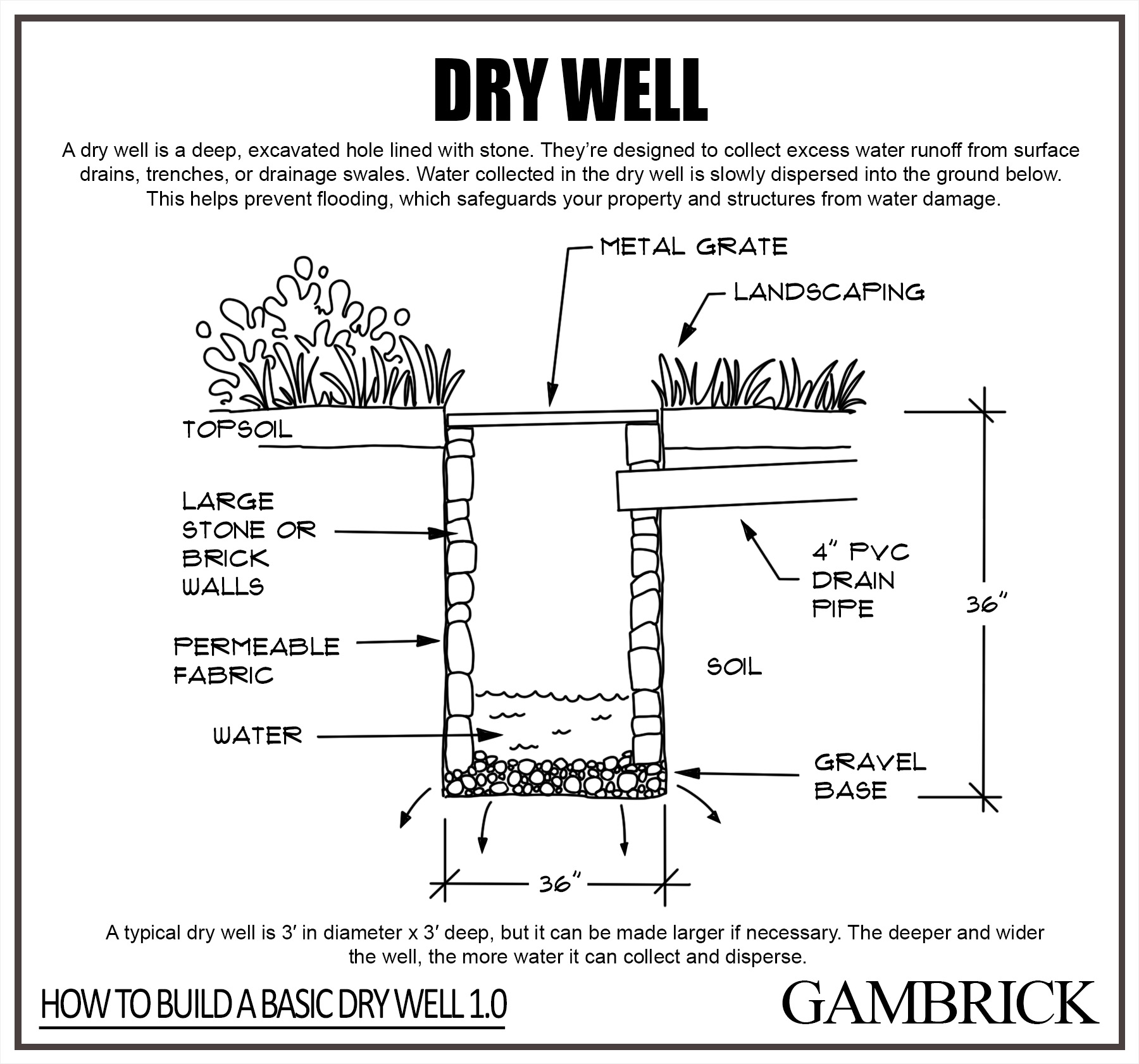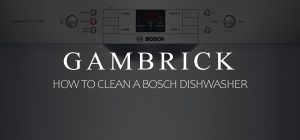French Drain Vs. Dry Well
Heavy rain can wreak havoc on your yard, causing irreparable damage to your fences, landscaping, hardscaping, patios, walkways, and foundations due to waterlogged surfaces and undermined footings. The solution is to build a permanent drainage system that effectively directs water flow and prevents drainage problems. The two best ways to manage excess runoff are a French drain and a dry well. Both methods help collect and divert water into deeper soil and gravel, but they differ in terms of depth, drainage capacities, and speed.
Dry wells and French drains are different ways to drain and control water flow and can be used in conjunction with one another.
- A dry well is a covered hole filled with gravel or stone. It’s essentially an endpoint for your drainage system. Water is diverted into the dry well, where it collects, filters through the gravel, and distributes deep into the soil.
- A French drain is a drainage trench that collects water and directs it downhill. Every French drain needs an endpoint where the water will flow into. A great way to end a French drain is into a dry well.
When comparing a French drain vs. a dry well, consider the slope of your property, the amount of water you’re dealing with, and what you’re trying to protect.
In this article, I’ll explain the characteristics of French drains vs. dry wells, what they’re best used for, how to build them, and when you should use them.
Let’s take an in-depth look at the differences between these drainage solutions so you can choose the best yard drainage system for your property.
What Is A French Drain?
A French drain is an outdoor trench filled with gravel and a perforated pipe. Its purpose is to gather excess water flow and funnel it downhill to a single location. The primary goal of a French drain is to safeguard things like your foundation, landscaping, patio, basement, etc., from potential water damage caused by excess water. French drains can also help alleviate hydrostatic pressure that may build up against retaining walls or foundations.
A French drain is one of the best water management systems you can use to protect your home. If you’re having trouble with excess rainfall washing into your home or other areas you want to protect, a French drain may be able to help.
How Does A French Drain Work?
A French drain collects water runoff using a thick gravel layer surrounding a perforated drain pipe. Water that seeps into the gravel enters the pipe and diverts downhill to a single location. However, debris and sediment are too large to filter through the gravel and into the pipe, so it collects on the surface where it can be cleaned.
- Compared to a dry well, a French drain is fairly shallow and very long. They’re designed to prevent flooding by channeling water to low-lying areas of the property or into a gutter or dry well.
- French drains always run downhill.
- The slop of your property diverts water into the French drain, which then collects it and diverts it into a gutter, dry well, or low-lying area.
- To enhance its effectiveness, a French drain system may also include a drain fabric, crushed stone, or a rain barrel for water filtration and contamination prevention.
Unlike dry wells that are usually very deep and in a single location, a French drain is fairly shallow and can extend for hundreds of feet.
The size of a French drain should be scaled to match the amount of water you deal with. For example, the average French drain uses a 4″ perforated pipe; however, you can use a 6″, 8″, 10″, or 12″ pipe to divert larger amounts of water. You can also speed up the flow of water by angling the drain at a steeper pitch.
Installing a French drain is more complex than a dry well because it has to flow downhill at an angle of at least 1%, which is 1 inch per 10 feet. A dry well is easier to excavate because it’s just a single hole dug straight down without a pitch to worry about.
Where Do You End A French Drain?
The best way to end a French drain is into a dry well, pond, water garden, or storm drain. An outlet is crucial for a French drain to prevent flooding. Always check local laws and building codes for any construction restrictions before terminating your French drain. Never allow the French drain outlet to drain onto the neighboring property; this is illegal, and your responsibility to manage the collected water.
A dry well is a great way to end a French drain if you don’t have anywhere else to divert the water. Any water collected by the drain will dump into the dry well, which then absorbs into the soil below.
How To Maintain Clean French Drains
To avoid sedimentation and clogging issues in French drains, make it a habit to clean them annually using regular pressure washers or high-pressure water jet cleaners. This simple maintenance task will ensure your French drains continue to function effectively and prevent potential drainage problems.
French Drain: Cost, Lifespan, and Pipe Materials
- Cost: French drains are relatively affordable, with an average price range of $10 to $50 per linear foot.
- Lifespan: French drains can last for decades if properly maintained.
- Pipe Materials: Perforated PVC pipe works best.
- Gravel: I use 3/4 smooth gravel around the pipe and tamped down as a base under the pipe. You can then use larger, more attractive stone as a top layer.
- Fabric: Use permeable landscaping fabric that lets water through but not solids.
What Is A Dry Well?
A dry well is a deep, excavated hole lined with stone. They’re designed to collect excess water runoff from surface drains, trenches, or drainage swales. Water collected in the dry well is slowly dispersed into the ground below. This helps prevent flooding, which safeguards your property and structures from water damage.
A typical dry well is 3′ in diameter x 3′ deep, but it can be made larger if necessary. The deeper and wider the well, the more water it can collect and disperse.
Dry wells are an excellent way to manage excess water on your property. However, they work best when built in the lowest part of the property where water naturally flows and combined with other water management systems, such as swales, drenches, or French drains which divert water into the well.
If you build a dry well, I recommend installing a strong metal grate on top to prevent people from falling into the well.
What’s The Purpose Of A Dry Well?
A dry well serves as the endpoint for a drainage system, effectively receiving and dispersing water below ground. If you can’t direct runoff into a storm drain or water garden, a dry well is an excellent solution. It allows runoff water to seep deep into the soil below your yard’s surface, preventing standing water and providing an Eco-friendly solution for managing excess water.
- Dry wells collect large amounts of water that is then dispersed underground.
- A dry well is part of a drainage system, receiving runoff water from sources like gutter downspouts, drainage ditches, or French drains.
- Dry wells don’t collect runoff on their own, needing a drainage pipe or other system to direct water into the dry well.
- By installing a dry well, there’s no need to terminate a drain above ground, preventing potential flooding and erosion.
- In some regions, channeling runoff water into municipal storm drains may be impractical or against the law. A dry well offers an underground solution, avoiding lawn flooding caused by water from downspouts.
Overall, using a dry well as part of your drainage system efficiently manages runoff water, keeping your yard dry and preventing environmental concerns associated with excess surface water runoff.
Do Dry Wells Work?
Dry wells are a great way to deal with excess water on your property. If you see heavy rainfall or snow and have nowhere to drain all the water, a dry well can help. It provides a place to drain water, which then disperses deep into the soil below. The more water you need to remove, the deeper you can dig the well.
- Dry wells have been used for hundreds of years.
- They can be sized to match the amount of water you need to drain.
- Simple dry wells lined with landscape fabric and filled with gravel are very effective.
- Dry wells work best when used in conjunction with trenches, swales, or a French drain.
- Tanks can be buried inside the dry well to make them even more effective.
- Dry wells work best in soil that absorbs water, such as rocky or sandy soils. But they don’t work well in dense clay or caliche.
A percolation test can help you determine if a dry well is right for your soil. Dig a deep hole, fill it with water, then watch how quickly the water is absorbed into the soil. If the water stays stagnant for long periods of time, your soil is too dense for a dry well.
Does A Dry Well Need To Be Pumped?
Dry wells require no pumping or regular emptying. Unlike solid tanks, they’re simple holes filled with large gravel. The gravel maintains the well’s shape and facilitates water filtration. Water filters down through the dry well and leaches into the surrounding soil as groundwater. With minimal maintenance needs, dry wells offer an effective and natural way to filter water, ensuring proper drainage and groundwater recharge.
Why Do Dry Wells Fail?
Dry wells can fail due to various reasons:
- Clogging: Over time, debris and sediment can accumulate in the dry well, leading to clogging and reduced water absorption.
- Inadequate Size: If the dry well is not sized appropriately for the water volume it receives, it can overflow during heavy rain.
- Wrong Location: Placing the dry well in an area with poor soil drainage or near the home’s foundation can result in ineffective water dispersal.
- High Water Table: A high water table can cause the dry well to fill up quickly, preventing proper water infiltration.
- Clay Soil: Dry wells may not work well in clay soils, as these soils have low permeability, hindering water percolation.
- Lack of Maintenance: Failure to perform regular maintenance, such as cleaning and inspection, can lead to reduced performance and potential failure.
To ensure the effectiveness of a dry well, proper design, size, and location, along with routine maintenance, are crucial factors to consider.
Can a Dry Well Cause a Sinkhole?
Yes, a dry well can potentially cause a sinkhole. When a dry well is not properly designed or installed, it may lead to changes in groundwater levels and drainage patterns. This can weaken the soil above the dry well, eventually causing a sinkhole to form.
To prevent this, it’s important to ensure that the dry well is constructed with proper support and adequate materials, such as thicker walls and 1-inch river rock, to enhance stability and minimize the risk of sinkhole formation.
Regular inspection and maintenance are also essential to detect any issues early and address them promptly, reducing the chances of sinkhole development.
Dry Well: Cost, Lifespan, and Pipe Materials
- Cost: Dry wells have an average cost of around $3,000 to $10,000 depending on the width and depth of the well.
- Lifespan: Dry wells can last for decades if properly maintained.
- Pipe Materials: Perforated PVC pipe works best.
- Gravel: I use 3/4 inch smooth gravel as a base material with large stones along the sides of the well. However, if I’m using a dry well tank, I surround it with 3/4 inch smooth gravel.
- Surface Layer: If I’m burying a tank, I typically use large stones on the surface or grass. If my dry well is open, I cover the hole with a large metal grate to prevent someone from falling into the well.
- Fabric: If you use fabric, choose a permeable landscaping fabric that lets water through but not solids.
The Difference Between A French Drain And A Dry Well
Both French drains and dry wells serve to address flooding and surface water issues, but they have distinct differences in terms of depth, cost, installation, and maintenance, affecting their suitability for your yard drainage needs.
1. Location
The location where you build a French drain vs. a dry well is very different. A French drain is shallow and very long, some extending hundreds of feet. It collects water as it runs downhill to protect your property from runoff. However, a dry well is the end point where excess water is funneled. They’re deep and in a single location
- French drains are typically installed around gardens, lawns, driveways, patios, and against foundations to collect excess water.
- French drains can extend hundreds of feet.
- Dry wells are built in a single low-lying area away from the home.
- Water management systems, like French drains and trenches, funnel water into the dry well.
In general, a dry well is built far away from a home in a single area with a low elevation. This makes diverting water into the well much easier because water always runs downhill to lower ground.
French drains can be built at the bottom of hills, around patios, landscaping, and gardens, or against a retaining wall or foundation to prevent water damage and erosion.
2. Function
Although both a French drain and a dry well are designed to deal with excess water flow, they perform different functions.
- French drains collect water flow over a long distance and redirect it to low-lying areas. This helps prevent flooding and water damage.
- The function of a French drain is to collect water and direct it to a new location.
- Dry wells accept water from various surface and runoff drainage systems, holding it before percolating it into the surrounding soil and gravel.
- The function of a dry well is to collect water and drain it into the soil below.
When designing a drainage system for your property, consider the function of both a dry well and a French drain.
French drains are great around your landscaping, patio, retaining wall, or foundation to collect water and divert it somewhere else, like a dry well.
A dry well is the end point of a French drain, trench, or swale. It’s where other water management systems drain their water.
3. Cost
French drains are shallow and long trenches with gravel and a perforated pipe inside. They’re typically priced per linear foot based on the size of the trench, the size of the pipe, and what type of stone is used. Depending on the length of the trench and its design, a French drain could be less expensive than a dry well or a lot more expensive.
- French drain costs can vary between $10-$50 per linear foot based on the design, size, and location of the drain.
Dry wells are built in a single low-lying location on your property. They’re typically 3 feet in diameter and 3 feet deep, lined with stone, and have a gravel bottom which promotes good drainage into the soil below. Their price can vary based on the diameter and depth of the well as well as the type of stone and gravel used.
- A typical 3’x3′ dry well has an average cost of $3000 to $10,000.
- Dry wells have a more fixed price than a French drain.
4. Repairs
A French drain is much easier to repair and clean because they’re shallow and easy to work on. It’s easy to snake out clogs and clean debris from the surface. However, dry wells are larger and deeper, which makes them harder to repair.
- French drains are relatively easy to repair, typically requiring some basic cleaning to work properly.
- Dry wells are more complex to repair, often needing excavation work when clogged.
5. Build
French drains are much easier to build and make a great DIY project. They’re fairly shallow, usually just 12 inches deep, and in their simplest form, contain just gravel and a perforated drain pipe. However, dry wells are wider and deeper, using larger stones to line the exterior well wall.
- French drains are easy to build, including a small perforated pipe and gravel. In some cases, landscaping fabric can also be used to keep stones and other objects out of the pipe.
- French drains can be built with basic hand tools, such as a shovel, wheelbarrow, and hoe.
- Dry wells are elongated stone or concrete tubes with thicker walls, capable of holding and storing water before gradually draining it into the surrounding soil.
- Deep dry wells typically require excavation equipment.
Understanding the differences between French drains and dry wells will help you choose the best yard drainage solution for the water problem you’re facing.
Comparing French Drain Vs. Dry Well
Here’s a comparison chart showing the average French drain vs. the average dry well:
| French Drain | Dry Well | |
| Depth | 8 – 12 inches | 3 feet |
| Cost | Typically cheaper, but depends on the size and linear foot of the drain | Typically more expensive, but depends on the diameter and depth |
| Water Source | Rain or Snow | Drainage systems such as trenches, swales, and French drains |
| Type of Soil | Any | Any |
| Distance | Close to the foundation, landscaping, hardscaping, etc. that it protects | As far away as possible |
| Visibility | Can be completely hidden below the surface | Easily visible |
| Speed of Drainage | Moderate, but it depends on the size of the drainage pipe and the slope | Typically high, but it depends on what’s feeding into the well |
| Terrain | Any, but works best when at the bottom of sloped ground | Any |
| Installation | Easy, can be done as a DIY project | Moderate, but it gets harder the deeper the well is |
| Gravel | Any, but 3/4″ round gravel works best | Any, but 3/4″ round gravel works best for the base, larger stone for the side walls |
Understanding these differences will help you choose the most suitable drainage solution for your specific needs.
French Drain vs. Dry Well: Which Is Best
When comparing a French drain vs. a dry well to determine which is best for your property, the answer depends on what type of water issue you have.
French drains are best for collecting water runnoff over long distances and diverting it somewhere else. For example, you can install a French drain along the entire perimeter of your home to keep water from settling near your foundation. However, French drains just collect and divert water somewhere else, so they need an endpoint.
A dry well is the end point of a trench or French drain. Any water collected by the drain can be dumped into the dry well where it then absorbs into the soil below.
Which Is Best For For Heavy Rain?
What type of drain is best for heavy rain depends on the topography of your property and what you’re trying to protect. If the slope of your land runs water directly into your landscaping, hardscaping, garden, or home, a French drain is best. They can be dug along the path of the water runoff to divert it somewhere safe. In this scenario, a dry well wouldn’t help much.
A dry well is best if you already have good drainage but get a large standing pool of water in a single location. Building a dry well in that spot will allow the water to drain into the well and the soil below, thus eliminating the pooled water.
- Dry Wells: Ideal for high rainfall areas that pool water in a single location or have nowhere to drain runoff.
- French Drains: Don’t hold water and can overflow during heavy rain if they’re undersized and not sloped properly. However, they’re essential to protect the majority of property types from runoff.
In regions with frequent heavy rain, a combination of French drains and a dry well works best because they perform different functions.
French drains collect and divert heavy rainfall to a new area, but they don’t drain water. Dry wells are a collection point for large amounts of water, but without a French drain or trench supplying water to them, they’re not that efficient.
Which Can Handle More Water
In terms of gallons per minute, the average dry well can handle a higher volume of water compared to a French drain. However, it depends on the size of the dry well vs. the size of the drain pipe. But you also have to consider real-world applications. Even though a dry well can handle more total water, it needs trenches, drains, or swales to funnel water into the well. Without a way to divert water into the well, it’s not typically the best option.
French drains will typically handle less water per minute than a dry well; however, they span a much greater distance and collect water running downhill. They’re a much better defense against water runoff than a dry well alone.
- Dry Wells: Offer a higher water capacity measured in gallons per minute than a French drain. However, something has to funnel water into the well.
- French Drains: Can handle less total water but are better in real-world applications.
Dry wells outperform French drains in terms of water capacity, processing more water per minute. However, in areas prone to flooding, you can increase the French drain’s flow by incorporating a sump pump or installing a larger pipe, providing a viable solution for handling excess water.
It’s also important to remember that without a trench, drain, or swale to divert water into the well, it won’t collect much water.
Which Is Best For Water Runoff?
A French drain is much better for collecting water runoff than a dry well unless all the runoff funnels into a single location. The average dry well is 3 feet in diameter, so all the runoff water would have to funnel into that small area in order for the well to be effective. However, a French drain can span hundreds of linear feet so that it can handle water runoff on a much larger scale.
- French Drain: The best way to capture and redirect water runoff away from a structure, garden, patio, retaining wall, etc., preventing potential flooding.
- Dry Well: Collects large amounts of runoff in a single location. Dry wells are best when paired with drains that feed into the well.
When it comes to drainage solutions, the French drain stands out as the best option for dealing with water runoff. They collect water runoff and divert it to a new location, such as a sewer or dry well.
On the other hand, dry wells primarily serve as collection points for drains, trenches, and swales.
Which Is Easier to Install?
French drains are much easier to install than a dry well. The average French drain’s trench is 8-12 inches deep by 8-12 inches wide and holds a 4-inch perforated pipe surrounded by 3/4 inch gravel. This is a job the average homeowner can handle by themselves as a weekend DIY project. All it requires to build are some basic hand tools to dig the trench and spread the gravel and a level to check its pitch.
A dry well is much wider, generally having a 3 foot diameter, and much deeper, with an average depth of 3 feet. However, they can be wider and much deeper depending on the amount of water you want to collect.
Some dry well designs contain a plastic dry well that’s fed by plastic tubing or pipe. All this extra work makes them harder to install than a simple French drain.
- Dry Wells: Installation is harder because the hole is wider and deeper and may involve installing a plastic dry well.
- French Drains: Installation is easier because the trench is narrow and shallow.
Due to their depth, dry wells can be much harder to install vs. a French drain. I’ve installed large dry wells that were over 5 feet deep and required a mini excavator for digging. Depending on the size and depth of your dry well, it could require excavation machinery or professional help.
On the other hand, French drains are narrow and shallow and only require basic hand tools you can buy at any Home Depot. If fact, Home Depot also sells perforated pipe, gravel, and landscaping fabric, so you can get everything you need in one place.
Can You Use A French Drain & Dry Well Together?
Yes, using a French drain and dry well together is one of the best ways to handle water runoff and standing water issues. A French drain is best for collecting large amounts of water runoff heading toward your house, garden, retaining wall, or landscaping. However, every French drain needs a place to divert all the water it collects. This is the purpose of the dry well.
You can terminate a French drain into a dry well if you don’t have a sewer system or some other way to deal with all the water. For the best results, use a dry well that’s sized for the amount of water you can collect with your French drain.
Using a dry well that’s too small for your French drain could result in water backing up into the pipe.
Make sure to filter out heavy clay content, stones, debris, and roots to prevent clogs in both the well and drain This setup allows for efficient water management and drainage.
How to Use a Dry Well and French Drain Together
The best way to manage excess water runoff on your property is to use a dry well and French drains together. French drains collect water running downhill towards things like your home, a retaining wall, a garden or your landscaping. The drain then dumps all that water into the dry well where its absorbed into the soil below.
To use a dry well and French drain together, follow these simple steps:
- Dig a drainage trench with a 1-2 inch slope for every 10 feet.
- Install a French drain in the trench using landscape fabric, gravel, and perforated pipe.
- At the end of the drainage trench, dig a dry well, approximately 3 feet in diameter and 3 feet deep.
- Fill the dry well with landscape gravel or use a dry well tank surrounded by landscape gravel on all sides, including the bottom.
- Direct the end of the drainpipe into the center of the dry well.
- Cover the dry well with turf or a grate.
With proper installation and soil that doesn’t have heavy clay content, the runoff water will quickly percolate into the soil as groundwater. A well-designed dry well rarely overflows, making this combination of French drains and dry well an effective and reliable solution for managing water on your property.
Tips For Choosing The Best Drain For Your Yard
- Install French drains on naturally sloping portions of the site.
- Limit dry wells to site corners and flat terrain.
- Choose French drains for capturing runoff in larger yards.
- Opt for dry wells to prevent standing water in smaller areas.
- Use French drains near basements and foundations to prevent water damage.
- Limit dry wells to above-ground applications.
- Consider dry wells for marshy areas with mosquito problems.
- Select dry wells for coarse-soil sites.
- Choose French drains for clayey or loamy soils.
- Pick dry wells for larger yards and sites.
- Use French drains for compact sites and bungalows.
Summary: French Drain Vs. Dry Well
Heavy rain can wreak havoc on your yard, causing irreparable damage to your fences, landscaping, hardscaping, patios, walkways, and foundations due to waterlogged surfaces and undermined footings. The solution is to build a permanent drainage system that effectively directs water flow and prevents drainage problems. The two best ways to manage excess runoff are a French drain and a dry well. Both methods help collect and divert water into deeper soil and gravel, but they differ in terms of depth, drainage capacities, and speed.
Dry wells and French drains are different ways to drain and control water flow and can be used in conjunction with one another.
- A dry well is a covered hole filled with gravel or stone. It’s essentially an endpoint for your drainage system. Water is diverted into the dry well, where it collects, filters through the gravel, and distributes deep into the soil.
- A French drain is a drainage trench that collects water and directs it downhill. Every French drain needs an endpoint where the water will flow into. A great way to end a French drain is into a dry well.
When comparing a French drain vs. a dry well, consider the slope of your property, the amount of water you’re dealing with, and what you’re trying to protect.
In this article, I’ll explain the characteristics of French drains vs. dry wells, what they’re best used for, how to build them, and when you should use them.
Let’s take an in-depth look at the differences between these drainage solutions so you can choose the best yard drainage system for your property.
If you have any questions or comments about a French drain or a dry well, email any time.























